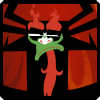I had the gun for quite some time just never took a picture of it. It needs a little more spackling and some sanding before it's ready to be painted. Oh, BTW I found out that joint compound dry wall spackling is wonderful stuff for this project. I'll continue to use the Bondo for the strength and rigidity, but the Drywall goes on Really smooth and is much easier to work with. It also sands off Really easy. It is prone to cracking so heed some caution there. I'm hoping that after I put some laytex paint as a base coating it will help prevent that.

The Shield is almost there too. It took a whole lot of Bondo and Spackling to smooth everything out. But another day of sanding and it should be ready for painting. (If it ever gets warm or dry enough) I do have to say I am getting a bit concerned about the weight. This lightweight shield has become quite dense over time. I'll have to rig up something Very sturdy on my arm to hold it.

So as the title of the blog says. . . I wanted to show an easy way to get complex patterns from your model. (You can also do this for the easy straight edges too) Everywhere there is a curved surface that's not structural, or has a lot of hard curves, I will be using this method. I first got the idea from another famous cosplay maker. You have probably heard of her over at http://www.amethyst-angel.com

Get some paper and wrap it around your model very tightly and tap it on. Use a pen and mark the edges of the part.

After marking take the paper off carefully and laminate it with tape. This will help preserve your pattern. Cut it out and try to be precise here because one human hair thickness will put your full size model off almost 1/16". That adds up quickly when your off a lot on the small scale.

After cutting put some other colored paper behind your pattern and place in a scanner. (The colored paper helps your pattern scan better) Use some program to resize and print. (Paint works just fine) Cut out your large pattern and there you go. Quick and Dirty. I'm doing this for the shielding around the calves and some of the leg and arm pieces. I ran out of the ABS plastic so I need to buy some more. (Quickly running out of the foam too) Mr. Sazabi is getting expensive.
